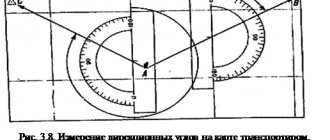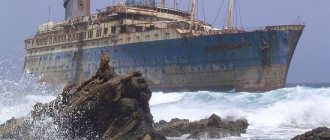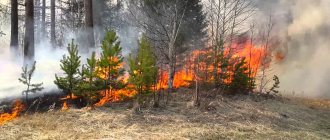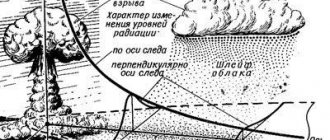general information
AHOV (meaning emergency chemically hazardous substances) are compounds that can spoil soil, air, water, and harm the health of people or animals. Over time, their number increases (today there are 34). The main list includes:
- chloropicrin;
- methyl bromide;
- hydrogen halide;
- acrylonitrile;
- hydrocyanic acid;
- phosgene;
- cyanogen chloride;
- ammonia;
- chlorine;
- carbon disulfide, etc.
All of them can be used as initial or auxiliary elements in industry, or formed during the production process. Enterprises that carry out their activities with their direct participation are called chemically hazardous enterprises or chemical enterprises (chemically hazardous enterprise or facility). These include oil refining, ferrous and non-ferrous metallurgy, the production of mineral fertilizers, etc.
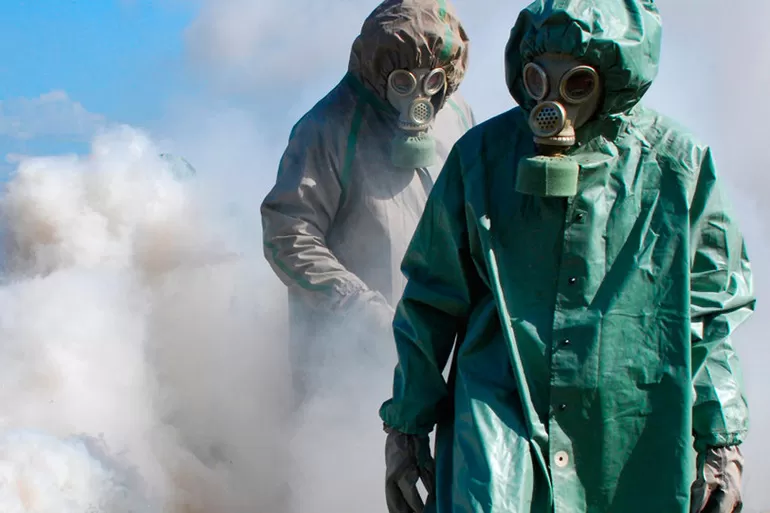
The characteristics of hazardous chemicals and their damaging factors are frightening. They enter the human or animal body through the respiratory tract or skin. Some cause harm when they enter the body through the mouth (orally). In any case, the final destination of the substance is the blood, through which it spreads everywhere and entails mainly death.
It is also dangerous that hazardous chemicals can negatively affect the body, regardless of its physical state. First, the place of direct contact is affected. Then the mucous membranes suffer, and sometimes the larynx becomes inflamed, interfering with normal breathing.
But not all substances act this way; the effects may vary.
Emergency
Chemical accidents: reality and trends
The occurrence of emergency situations (ES) caused by chemical accidents and disasters is quite real in today's conditions. Moreover, in recent years their likelihood has been constantly increasing.
Today, thousands of chemical accidents occur in the world during the production, storage, and transportation of hazardous chemical substances (HAS). The largest number of accidents in the world and in Russia occur at enterprises producing or storing chlorine, ammonia, mineral fertilizers, herbicides, organic and petrochemical synthesis products.
In Russia there are more than three thousand six hundred chemically hazardous facilities, and one hundred forty-six cities with a population of more than one hundred thousand people are located in zones of increased chemical danger. Over five years - from 1992-1996 - more than 250 accidents involving the release of hazardous substances occurred, during which more than 800 people were injured and 69 people died. Moreover, 25% of accidents occurred due to the operation of equipment beyond the standard period, corrosion of equipment and inoperability of control and measuring equipment.
Among the largest chemical accidents in recent years in the world, the following can be noted.
In 1976 at a chemical plant in an Italian city. An accident occurred in Seveso, as a result of which an area of more than 18 km was contaminated with dioxin. More than 1,000 people were injured, and there was widespread death of animals. Elimination of the consequences of the accident lasted more than a year.
Probably the largest accident in chemical production in the entire history of the development of world industry was the disaster in Bhopal (India, 1984), due to which 3,150 people died and more than 200 thousand were injured of varying degrees of severity.
In 1988, during a train accident in Yaroslavl, a spill of heptyl, which belongs to the first toxicity class, occurred. About 3 thousand people were in the possible destruction zone. About 2 thousand people and a large amount of equipment took part in eliminating the consequences of the accident.
In 1989, a chemical accident occurred in Jonava (Lithuania). About 7 thousand tons of liquid ammonia spilled over the territory of the plant, forming a lake of toxic liquid with a surface area of about 10 thousand square meters. m. As a result of the fire, a warehouse with nitrophoska caught fire, its thermal decomposition with the release of toxic gases. The depth of spread of contaminated air reached 30 km and only favorable meteorological conditions did not lead to the defeat of people, because a cloud of contaminated air passed through uninhabited areas. 982 people and 241 pieces of equipment were involved in eliminating the consequences of this accident.
In August 1991, 32 tanks containing liquid chlorine derailed during a train accident in Mexico. About 300 tons of chlorine were released into the atmosphere. In the area where the contaminated air spread, about 500 people suffered injuries of varying severity, of which 17 people died on the spot. More than a thousand residents were evacuated from nearby settlements.
The given examples give an idea of the scale of the possible consequences of chemical accidents, which gives grounds to talk about the relevance of the problems of their prevention and elimination, the protection of personnel and the population.
Forecast estimates for the near future show that the trend toward an increase in the likelihood of chemical accidents will continue in the near future. There are a number of prerequisites for this:
-growth of complex industries using new technologies that require high concentrations of energy and hazardous substances,
-major structural changes in the country’s economy, which led to the shutdown of a number of production facilities, disruption of economic ties and disruptions in technological chains;
-high and progressive wear and tear of fixed production assets, reaching 80-100% in a number of enterprises;
-decrease in technological and production discipline, level of qualification of technical personnel;
-accumulation of production waste hazardous to the environment; -reducing the demands and efficiency of supervisory authorities;
-high concentration of population living near potentially hazardous industrial facilities;
-absence or insufficient level of preventive measures that can reduce the scale of the consequences of chemical accidents and reduce the risk of their occurrence;
— insufficient legislative and regulatory framework;
— an inevitable increase in the volume of chemical production, the transition to full-load operation of the country’s largest chemical complexes, an increase in the volume of transportation and storage of hazardous chemicals;
-the desire of foreign states and companies to invest in hazardous industries in Russia;
-increasing likelihood of terrorism in chemically hazardous industries.
According to expert calculations, the cost of preventing accidents is many times less than the amount of damage they cause if they occur. Therefore, all over the world, very great importance is attached to the safety of chemical production.
The safety of the operation of chemically hazardous enterprises depends on many factors - the physical and chemical properties of raw materials, semi-finished products and products, the nature of technological processes; equipment design and reliability; conditions for storage and transportation of hazardous chemicals; condition of control and measuring instruments of automation equipment; effectiveness of emergency protection equipment; level of organization of preventive work; availability and perfection of diagnostic complexes; timeliness and quality of scheduled preventive maintenance work; preparedness and practical skills of personnel; system for monitoring the state of the technical emergency protection environment.
Judging by the available statistical data today, many complex technical complexes have “internal inherent danger”, and a very significant one.
Complex technical systems (CTS) in our country and abroad are in most cases created using traditional design rules and simple engineering methods, calculations and tests without justification for their safety.
It is clear that it is absolutely necessary to develop and implement new approaches and principles for ensuring the safety of chemical production. The main requirements are the exclusion of particularly dangerous accidents that can lead to death, injury to people, significant material damage, and have a significant impact on the environment; ensuring an analyzed, calculated and controlled level of security.
In the event of chemical accidents, the most dangerous are hazardous chemicals, which in emergency situations relatively easily change from one state of aggregation to another, most often from liquid to gaseous (vapor), from solid to aerosol and cause massive damage to people, animals and plants.
The success of measures to protect production personnel, the public and emergency rescue operations depends on a number of factors.
One of them is the detection of prerequisites (threats) and the very fact of accidents occurring, notification of working personnel, as well as the population in areas of possible infection.
The system for detecting the threat and the fact of the occurrence of chemical accidents must anticipate the accident at the stage of its “inception”. Existing accident detection systems do not have means of monitoring emissions of toxic substances with determination of their concentrations and distribution zones, or these means are imperfect. According to Gosgortekhnadzor of Russia, about 80% of existing technical equipment have a service life of more than 20 years and are morally and physically outdated.
It is possible to increase the efficiency of detection of chemical accidents by creating an automated system for continuous remote detection of hazardous substances accidents (ASD-Lidar complex) in addition to on-site monitoring systems, by increasing the level of technical equipment, as well as the degree of interconnection of the technical means available to the duty dispatch service with accident detection means.
One of the most important tasks of protecting the population is organizing their warning and information in the event of an emergency. The operational speed of warning systems should be a matter of minutes. The actual warning time at most potentially dangerous objects is 25-30 minutes or more, which cannot be considered satisfactory. Increasing the efficiency of notification can be achieved by using automatic data processing and situation assessment systems using a system of automatic sensors that can immediately record the fact of an accident and automatically turn on warning systems in the threatened area. Unfortunately, work in this direction is progressing extremely slowly.
The success of emergency response largely depends on a quick and reliable assessment of the current situation in the chemical accident zone. To identify the chemical situation, universal gas monitoring devices UPGK, gas detectors of the GC series, and gas detectors of the UG-2 type equipped with a set of indicator tools are used. The disadvantages of these indicator tools are that they only allow for periodic monitoring of environmental contamination and do not provide rapid acquisition of situation data in case of sudden accidents.
The development of modern remote monitoring devices, manned and unmanned reconnaissance systems for conducting operational reconnaissance of the chemical accident zone is currently considered only as a promising task.
In the event of accidents at chemically hazardous facilities, the priority task is the immediate and effective implementation of emergency measures to protect workers and employees of enterprises and the population living in the area of possible spread of contaminated air.
The most reliable means of protecting workers, employees and the population from hazardous chemicals are shelters that meet certain requirements. However, the use of shelters to protect against hazardous chemicals is difficult for a number of reasons. The current regulatory deadlines for bringing shelters into readiness do not provide immediate shelter for people during chemical accidents; The state of equipment for air purification and regeneration leaves much to be desired.
To protect themselves from hazardous chemicals, production personnel at chemically hazardous facilities use self-contained breathing apparatus or industrial filter gas masks, as well as personal skin protection equipment. However, the production of personal protective equipment to ensure the technological safety of personnel at chemically hazardous facilities has sharply decreased in recent years (to 3-5% of demand), which threatens the timely refreshment of stocks of personal protective equipment at enterprises.
The main means of individual protection of the population from inhalation hazardous chemicals are civilian gas masks (GP-5, GP-7, GP-7V, GP-7 VM, GP-7 BC) and children's (DPF, KZD). All of them have one drawback - they do not protect against ammonia vapors, nitrogen oxides, ethylene oxide, methyl chloride and methyl bromide. To protect the respiratory system from the above-mentioned airborne chemicals, it is necessary to use additional cartridges DPG-1 and DPG-Z, which also protect against carbon monoxide. The problem is the timely provision of PPE to the population and ensuring the protection of children.
To date, research work has been completed to substantiate the creation of a new generation gas mask, which should provide protection against all 34 hazardous chemicals according to the nomenclature. In addition, new, more advanced industrial gas masks have been developed through conversion using the best domestic achievements in the field of gas mask technology. The task is to create their reserves.
A method of protection such as evacuation can be effective in case of long-term large-scale accidents, when there is a threat of the spread of a zone of chemical contamination.
The decisive condition for the successful withdrawal and evacuation of industrial personnel and the population from zones of chemical contamination is the implementation of this event in a short time, which is only possible with advance planning, clear implementation of notification and collection of evacuees, organization of transport and medical support, public order services and withdrawal management and evacuation.
The transition to new forms of management complicated the organization of accommodation for evacuees and their comprehensive provision.
Elimination of the consequences of a chemical accident includes a long series of operations:
conducting chemical control and reconnaissance in order to determine the area of contamination with dangerous concentrations of hazardous chemicals, determine the location of victims, the presence and degree of danger of secondary sources and factors of damage (fires, accidents on utility networks, etc.), control over the spread of hazardous chemicals;
localization and disinfection of the source of chemical contamination; localization of the spread of the primary and secondary cloud of hazardous substances; searching for victims, providing them with first aid and evacuating them from the contaminated area;
elimination of secondary damage factors, consequences of accidents on utility, energy and technological networks;
special treatment of equipment, sanitary treatment of people, disinfection of areas and water bodies; chemical control of completeness of degassing; waste collection and disposal.
In case of chemical accidents, the population is affected mainly by the primary and secondary clouds of contaminated air, the localization and disinfection of which is complicated by the inability to determine the position of the cloud and the lack of proven highly effective technologies for neutralizing hazardous chemicals in the vapor-gas phase.
To identify the size and configuration of a cloud of contaminated air and the direction of its spread, in our opinion, the most promising means may be a mobile remote chemical reconnaissance complex using a laser system for detecting chemical agents.
Existing stationary systems for localizing chemical accidents using water irrigation drainage systems often have low efficiency and need to be improved. The low efficiency of these systems is due to the relatively low solubility of most hazardous chemicals in water and, as a result, the need to supply a large amount of water to the accident site in an emergency, as well as the difficulty of ensuring contact of water with hazardous chemicals in the cloud, especially in winter.
To determine the parameters of a cloud of contaminated air and the direction of its movement, the most promising mobile operational control system under development, “ASD-Lidar,” may become the most promising.
The issue related to the creation, storage and use of reserves of degassing substances at facilities has not been fully resolved.
Of great practical interest are highly effective methods for localizing the source of contamination with hazardous chemicals by shielding the evaporation surface using foaming compounds and using various films and flake materials as screens. Practice shows that the use of screens can reduce the rate of evaporation of hazardous chemicals several times. In addition, to reduce the rate of evaporation of hazardous substances, cooling the spill surface with various inert coolers can be used.
The successful solution of emergency response tasks depends on the readiness of the forces, on their quantitative and qualitative condition, and the level of preparedness to carry out the relevant work. Today in the Russian Federation the foundation has already been laid for the functioning of a unique Unified State System for the Prevention and Response to Emergency Situations (RSChS), which has no analogues in world practice. Its uniqueness lies in the fact that systems of governing bodies and forces have been formed at both the federal, regional and local levels, and schemes for their interaction are being developed in the event of a threat and the very fact of an emergency. A certain regulatory framework has been created.
At present, we can confidently state that the first stage of creating the RSChS in Russia has been completed. At this stage, the tasks of creating a State system for rescuing the population in emergencies were mainly solved. The goal of the first stage—the creation of a state rescue service—has been largely achieved.
The main task of the current stage of development of RSChS is to reduce risks and mitigate the consequences of emergencies, i.e. implementation of a set of measures carried out in advance and aimed at minimizing the risk of an emergency as much as possible, as well as preserving people’s health, reducing the amount of damage to the environment and material losses in the event of their occurrence.
Since many catastrophes and natural disasters cannot be prevented, the fight to reduce damage and losses from them should be an important element of the country’s public policy, which is based on forecasting and timely warning of people about an impending disaster.
An important element of the sustainable development of world civilization is the development and implementation of preventive measures that can reduce and mitigate the consequences of natural and man-made accidents and disasters. The implementation of measures aimed at preventing emergencies requires coordination of the efforts of various ministries, departments, constituent entities of the Russian Federation and administrations of potentially hazardous facilities, as well as the use of the country’s scientific and technical potential.
Currently, the functional subsystems of the RSChS have very insignificant specially authorized control bodies and forces. On-site emergency recovery and emergency rescue units of constant readiness are small in number and have not been created in all potentially hazardous industries. A number of enterprises are experiencing difficulties associated with the disintegration of formations due to significant reductions in the number of production personnel. This provision significantly limits their ability to carry out rescue and other emergency operations and eliminate the consequences of chemical accidents. Therefore, at present, the basis of territorial forces in many regions is increasingly made up of civil defense troops (combined mobile detachments), as well as search and rescue service units of the Russian Ministry of Emergency Situations.
As a rule, the weak link in the planning and practice of using various formations is interaction, especially at the interdepartmental level. Here, the emergency commissions (ECS) and management bodies should play their main role, designed to ensure the proper effectiveness of the RSChS system in eliminating chemical accidents. Interaction between divisions and specialized departmental units must be planned at all stages of work.
The consequences of chemical accidents, although enormous, are not limitless. With appropriate measures to predict and prevent emergency situations, with the timely adoption of protective measures, and a decisive fight against them, the consequences of these accidents can be localized, and in some cases minimized.
This task will be better accomplished where close cooperation between government agencies, RSChS forces, and the population is established to ensure emergency preparedness for chemical accidents.
Head of the Center for Strategic Research of the Ministry of Emergency Situations, Ph.D., V.A. Vladimirov
Leading specialist of the Center for Strategic Research of the Ministry of Emergency Situations, Ph.D. n. Lukyanchenkov A.G.
Damaging properties
The damaging properties of chemically hazardous substances include toxicity. At a certain concentration, these elements can contaminate the air, water or soil so that they become unsuitable for humans or animals. In addition to concentration, consider:

- density depending on the state of aggregation;
- durability. The time during which the contaminated surface is cleaned independently or with the help of a person is taken into account;
- toxicity. It is assessed by dosages: how much a substance must be in order to harm living organisms.
Toxicity is divided into several groups depending on how the substance affects humans. It can have a nerve-paralytic, suffocating, irritating effect. Some disrupt their mental state, increasing the level of anxiety, paranoia, etc.
Classification of chemicals
Chemical contamination can occur with various substances, all of them have one common quality - toxicity to the human body. The degree of this quality varies from substance to substance. Depending on this, there are 4 hazard classes of chemicals:
- Extremely dangerous.
- Highly dangerous.
- Moderately dangerous.
- Low risk.
Any damaging substance can have a heterogeneous effect on the human body. But the main symptom is the one that leads to acute poisoning and damage.
Based on the nature of their impact, chemically hazardous substances can be divided into:
- Asphyxiants. These include chlorine and phosgene.
- Generally poisonous. Cause general intoxication of the body. These include carbon monoxide.
- At the same time, suffocating and generally toxic effects are exerted, for example, by nitrogen oxides, hydrogen fluoride, and sulfur dioxide.
- Neurotropic and suffocating effect, such as ammonia.
- Metabolic toxic substances, such as ethylene oxide.
- Substances that disrupt metabolic processes in the body.
Such substances, as a rule, are always found in excess at chemical plants. For example, workers at a nitric acid production plant must wear an L-1 protective suit. Personal protective equipment in the form of gloves, gowns, respirators, and even gas masks are present in workplaces.
Poisoning, symptoms, consequences
Dangerous hazardous substances can be divided into potent and non-critical ones. To make it more convenient to consider the categories, the features of poisoning are taken into account:
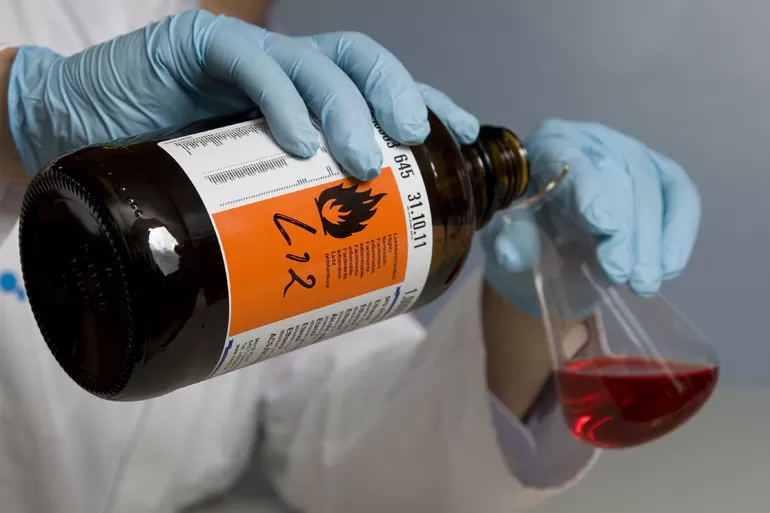
- carbon monoxide. When poisoned, it enters the bloodstream and interacts with hemoglobin. It displaces oxygen from it, leading to oxygen starvation. Mild and moderate poisoning is accompanied by vomiting, fatigue, and headache. Severe leads to a coma;
- hydrogen sulfide. In critical concentrations it causes instant death by blocking the respiratory system. Mild infection is accompanied by poisoning and irritation of the mucous membranes. Hydrogen sulfide is a strong toxic substance. If a person does not die after its exposure, he suffers all his life;
- hydrocyanic acid. By definition, it is considered one of the most potent poisons with neurotoxic effects. It is used in industrial enterprises, so household poisoning is rare.
In emergency situations, first aid is provided to victims. The body needs to be cleansed, so glucose and sodium thiosulfate solution are introduced. Gastric lavage is often prescribed. If medications are not available, life can rarely be saved.
The most dangerous disasters
Today's release of chemicals in Moscow and the region cannot be called catastrophic. It is within normal limits. But throughout the history of its existence, humanity has experienced many accidents at chemical weapons facilities. 6 man-made emergencies are recognized as the most dangerous:
- Italy, Seveso. In an Italian town in 1976, a major accident occurred with the release of hazardous chemical substances. About 18 sq. km turned out to be contaminated. The result was the death of animals. The injured people numbered in the thousands. The consequences were eliminated only a year later.
- England, Flixborough. In 1974 the town of Flixborough was seriously damaged. There was an accident at NIPRO, a plant that produced ammonium. Thanks to the quick response and adherence to safety precautions, only 55 people were killed, but another 75 were injured. The population of nearby cities was not affected.
- China, Suzhou. In 1978, one of the worst types of accidents at chemical hazardous facilities occurred in the Chinese city of Suzhou. A local river was contaminated with sodium cyanide; according to estimates, about 48 million people should have died. But thanks to the prompt intervention of a local newspaper, the number of victims was reduced to 3 thousand.
- India, Bhopal. The Union Carbide plant suffered a massive explosion in 1984. This is one of the most serious chemical accidents in the world. As a result, 4,035 people died and more than 40 thousand were injured. After the emergency, a toxic cloud of methyl isicyanate spread around the plant over a large area. The local soil was contaminated and was unusable for a long time.
- Switzerland, SANDOS. In 1986, an accident occurred at a Swiss chemical factory. Attempts to extinguish the fire resulted in tons of toxic chemicals spilling into the Rhine. Drinking water was poisoned and local fish died. Thanks to surgical intervention, it was possible to reduce the number of casualties to a minimum.
- Lithuania, Jonave. An emergency in Lithuania in 1989 led to liquid ammonia spilling throughout the plant. The poisonous lake spread over a surface of 10,000 square meters. m. Then a fire broke out and a warehouse with nitrophoska caught fire. During the decomposition process, it released toxic gases. We managed to escape with minor consequences, because there was no wind, and the contaminated air did not spread throughout the area.
Sometimes examples of accidents at chemically hazardous facilities are associated not only with production enterprises. In Russia, in Yaroslavl, in 1988 there was a railway accident. The train carried heptyl, a substance with the first level of toxicity.
Approximately 3,000 people were injured. Local specialists and volunteers were involved in eliminating the consequences.
Causes and consequences of accidents at chemically hazardous facilities
The main cause of emergencies is violation of safety regulations, improper operation or wear of equipment, as well as underestimation of warning systems.

Accidents at chemically hazardous facilities are no exception. Here, accidents also occur due to non-compliance with safety measures, wear and tear of equipment, or violations of production technology.

The greatest danger comes from accidents with uncontrolled release of hazardous substances
which occurs due to an explosion, fire or breakdown of industrial equipment.
For example, in 1984, the worst man-made disaster in a chemical production occurred in the city of Bhopal (India). The plant where the disaster occurred produced Sevin, a pesticide used to control pests of cotton, as well as vegetable and citrus crops. To produce sevin, a dangerous substance is required - methyl isocyanate
. This substance was stored in a huge factory tank, from where an emergency release of methyl isocyanate vapor occurred. The fact is that the temperature in the tank exceeded the boiling point - 39 degrees Celsius. As a result, almost 42 tons of toxic fumes were released into the atmosphere. This led to the death of eighteen thousand people, and another two hundred thousand suffered injuries of varying severity. There was no official version of what caused the accident, but most likely it was due to non-compliance with safety measures or due to wear and tear of equipment.

It must be said that the transportation of hazardous chemicals, which is carried out every day, poses a rather great danger. As usual, such substances are transported by road or rail.
In addition to the usual license plate, cars carrying hazardous substances are also marked with another sign with a four-digit number at the bottom. This number is the international code for a particular hazardous substance. Remember the most common of them: ammonia has the number 1005, aniline - 1547, gasoline - 1203, sulfuric acid - 1830, hydrochloric acid - 1789, methane - 1971, chlorine - 1017, ethylene - 1038.
If you witness an accident with cars with these (or similar) license plates, you should not approach them - this is extremely dangerous. This requires special personal protective equipment. For tanks filled with hazardous substances, they are usually painted in bright colors or have flashing lights.

An example of an accident during the transportation of hazardous chemicals is the accident that occurred in one thousand nine hundred and ninety-nine in St. Petersburg. The tanker truck carried four tons of butadiene - this is an extremely toxic substance, which, moreover, forms explosive gas-air mixtures. The leakage of this substance promised a powerful explosion at the slightest spark. This threatened to destroy not only the car itself, but also several houses adjacent to the road, and also lead to chemical contamination of a large part of the city. Fortunately, the tank was evacuated from the city, and no disaster occurred.

You have already become acquainted with the various characteristics of hazardous chemicals. Today, you will learn another important characteristic, which is called toxodose. Toxodosis
– this is a quantitative characteristic of the toxicity of hazardous chemical substances, corresponding to a certain level of damage when it affects a living organism.
In this regard, lethal toxodosis, average toxodosis and average threshold toxodosis are distinguished. Toxodosis is called fatal
if it causes death in half or more of those affected.
Toxodosis is called moderate
if it incapacitates half or more of those affected.
Finally, toxodosis is called mid-threshold
if half or more of those affected begin to show initial symptoms.

As we have already said, various hazardous chemical substances have different levels of toxicity
: It can be judged by the table that you see on the screen.

The main parameters of contaminated air are the mass of toxic substances contained in a unit volume of air. The table shows the values in milligrams per liter, which are enough to get one or another toxodose in a minute. For example, the lethal concentration of ammonia is 100 milligrams per liter, but the lethal concentration of hydrocyanic acid is only 1.5 milligrams per liter.
In the event of an accident involving the release of hazardous substances, a zone of chemical contamination
, that is, an area with dangerous concentrations of toxic substances for people.
The size of the source of chemical contamination depends on three main factors
: the amount of hazardous substance released, its toxicity, and weather conditions.
We have already talked about the first two factors, so now we will pay attention to how weather conditions
.

The fact is that the shape and size of the infection zone directly depend on wind speed. At very low wind speeds (up to 0.5 meters per second), the shape of the infection zone can be taken as a circle.

If the wind speed is between half and one meter per second, then the chemical contamination zone will be a semicircle. With a wind of 1 to 2 meters per second - a sector with an angle of 90 degrees, and with a wind of more than 2 meters per second - a sector with an angle of 45 degrees. In addition, wind speed naturally affects the speed at which an infected cloud moves.
Even with a wind of only 1 meter per second, the cloud can move 5-7 kilometers away from the accident in an hour. At a speed of 2 meters per second - at a distance of 10-14 kilometers, and at 3 meters per second - at a distance of 16 to 21 kilometers. When the wind speed exceeds 6 meters per second, the cloud dissipates quite quickly.

There is also such a thing as the depth of the infection zone
, that is, the distribution of hazardous substances by height. The depth of the infection zone also depends on meteorological conditions.

There are three degrees of so-called vertical stability of the atmosphere
. These are inversion, isotherm and convection.
Inversion
called the increase in air temperature as altitude increases.
A surface inversion can be tens or even hundreds of meters thick. This layer will trap various vapors, which will create the most favorable environment for the spread of dangerous concentrations of hazardous substances. Isothermia
is a typical condition for cloudy weather.
The layers of air are in some equilibrium, which also contributes to the stagnation of hazardous substances in the surface layer of the atmosphere. Finally, during convection
, layers of air move from one height to another, helping to disperse the cloud and reduce the concentration of hazardous substances. This phenomenon is most often observed on clear summer days.

As an example, let's consider the most typical chemical accident with the destruction of a hundred-ton container with a hazardous substance (which will be chlorine or ammonia). Let's take the wind speed to be 2 meters per second. Under such conditions, in the event of an inversion, the harmful effects of ammonia vapor will affect a distance of about 4 kilometers, and the effect of chlorine will affect a distance of 20 kilometers.

In the case of isothermia, the effect of ammonia will no longer extend over 4, but only one 1.3 kilometers, and the effect of chlorine will extend over 4 kilometers.

Well, in the case of convection, the negative effect of ammonia will affect a distance of 500 meters, and the negative effect of chlorine will affect a distance not exceeding 2 kilometers.

It must be said that with high concentrations of hazardous chemical substances released as a result of an accident at a chemically hazardous facility, people are affected very quickly. This can happen in just a few minutes if there are people in close proximity to the accident. Therefore, preliminary preparation is important, and it is also necessary to know about the rules of behavior and protective measures in such situations. This will be the subject of the next lesson.

Now let's take a look at the classification of accidents at chemically hazardous facilities according to the scale of the consequences. So, if we are talking about a minor leak of hazardous substances, then such an accident is called a private one
. Eliminating the consequences of this accident is not so difficult. It is much more difficult to deal with the consequences of a local accident.
The accident is called local
, if a fairly large container or even an entire warehouse of hazardous chemicals has been destroyed. In this case, the infected cloud reaches residential buildings.
If the cloud penetrates deep into populated areas, then such an accident is called regional
– here we can already talk about a significant release of hazardous substances.
Finally, there are global accidents
- these are accidents in which the complete destruction of all hazardous chemical storage facilities at a large chemically hazardous facility occurs. Most often this occurs as a result of an explosion. In this case, several residential areas may be in the zone of chemical contamination.

There are also four types of lesions
(abbreviated as OP), depending on the duration of infection of the area, as well as on the timing of the appearance of human lesions.
The first type of lesion is a lesion affected by unstable and fast-acting hazardous chemicals
- hydrocyanic acid, ammonia, hydrogen sulfide and some other substances.
Another type of lesion is a lesion caused by unstable, slow-acting hazardous chemicals
.
These substances include chloropicrin, phosgene and nitric acid. This is followed by damage from persistent, fast-acting hazardous chemicals
, for example, aniline or furfural.
And, finally, defeat by persistent slow-acting toxicants
. An example of such a substance is tetraethyl lead.

In order to quickly react when affected by fast-acting hazardous substances, you need to know what characterizes such lesions. Firstly, it is the simultaneous defeat of a large number of people within a few minutes (or several tens of minutes). Secondly, this is the rapid development of intoxication. Thirdly, injuries from fast-acting toxic substances are usually the most severe. And, of course, with such defeats, there is an urgent need for prompt first aid and evacuation of people from the affected area.

Lesson summary:
· Chemical contamination zone
– this is an area with dangerous concentrations of hazardous substances for people.
· The area in which mass casualties occurred is called a lesion focus
.
· We also became acquainted with the concept of depth of the infection zone. Depth of the infection zone
is the vertical distribution of a hazardous substance.
· Toxodosis
– this is a quantitative characteristic of the toxicity of hazardous chemicals, corresponding to a certain level of damage when it affects a living organism.
Why do accidents happen?
There are plenty of reasons for accidents in factories and enterprises. Most often they are associated with non-compliance with safety regulations. Oil, gas and radiation facilities operate according to certain rules. Their violation leads to emergency situations.
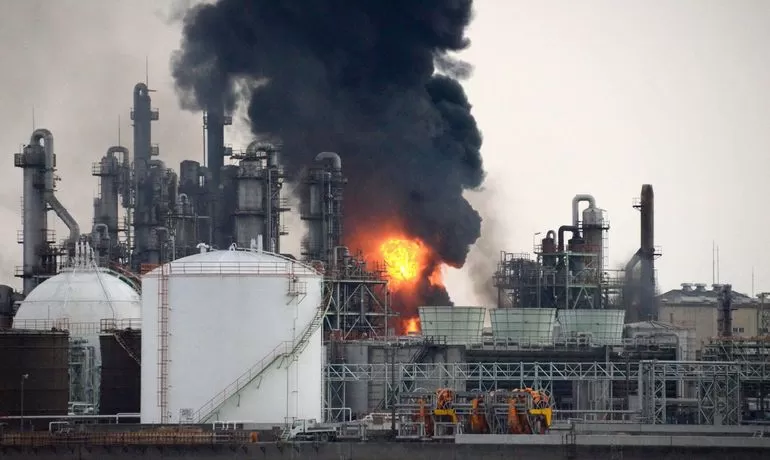
Another common cause of accidents is human factor. While an enterprise is provided with all safety standards, its employees may make mistakes in their work. Therefore, in modern times, they prefer to install new technological equipment at such facilities, automating the production process.
Old equipment often causes explosions. Equipment in factories requires periodic updating, as well as maintenance. There are also established operating rules, violations of which lead to problems.
Types of emergency situations
All accidents can be characterized as real disasters. If all means of protection are not used, it is difficult to eliminate the consequences. The most dangerous chemicals are those that leave indirect signs of poisoning. For example, exposure to hydrocyanic acid contributes to the formation of asthma and other complex and incurable diseases.
Emergency classification:
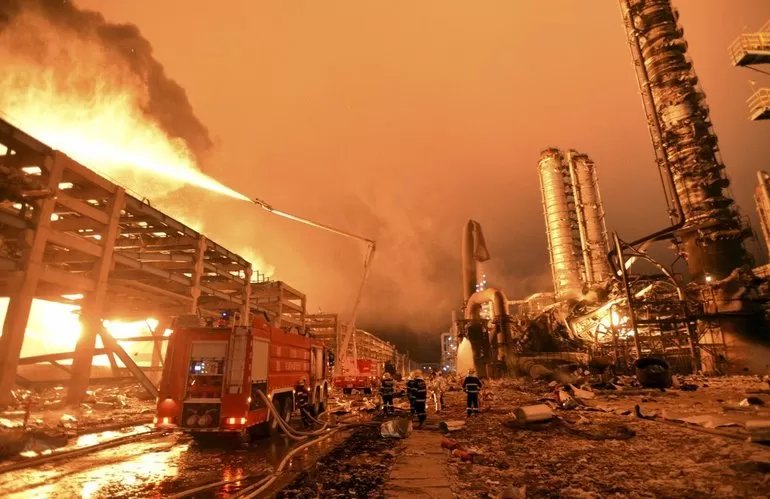
- release of chemicals during production or storage;
- accidents during transportation;
- the spread of chemically hazardous substances after explosions (for example, through the air due to wind);
- Emergency with ammunition.
Despite the small list, man-made disasters happen all the time. It is impossible to refuse the production of hazardous chemicals, because they are useful for any consumer. They are an integral part of agriculture, metallurgy, the fuel industry, household chemicals and many other industries. Therefore, all that remains is to adhere to precautions and safety measures.
Chemical Release Actions
Residents of cities and towns located in the immediate vicinity of chemical waste products/chemical storage facilities should familiarize themselves with the rules of conduct in case of accidents. They are recommended for implementation even after the consequences have been eliminated:
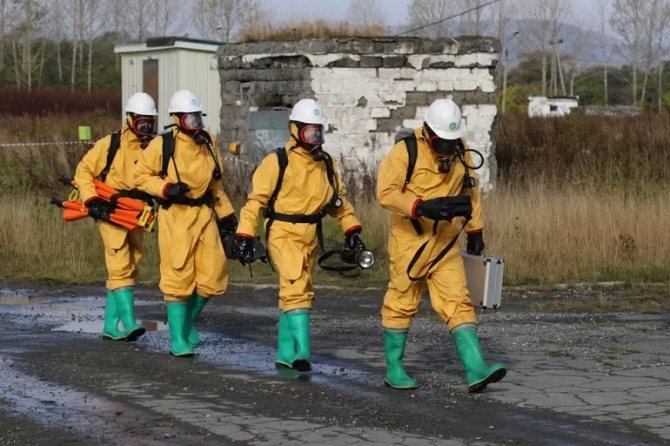
- stop eating vegetables and fruits grown in your own garden or sold outdoors;
- do not cook meat from animals slaughtered after the alarm has been declared;
- do not drink water, because its source could get into the lesion.
Canned food purchased before the emergency is allowed. If the affected area does not extend to a populated area, then they also eat fruits and vegetables that were stored in household warehouses. Of course, purchased or collected before the alarm began.
Actions in case of a chemical accident
Every person must understand what to do during and after an accident at a chemical facility. If it is indoors, the procedure is as follows:
- Close windows, doors, ventilation or smoke openings. Seal the gaps in the joints of the frames with adhesive plaster or other material. Hang blankets and bedspreads on windows and doors.
- Protect the respiratory tract with a mask, respirator or regular gauze (fabric) bandage soaked in an aqueous solution. In case of accidents with the release of chlorine, the bandage is soaked in a 2-5% solution of baking soda, ammonia - 2% solution of citric or acetic acid.
- Do not turn on electrical appliances, turn off heat sources, turn off the gas.
If necessary, leave the premises, take documents and the minimum necessary things, put on clothing that covers the body (rubber boots, raincoat, hat).
Procedure if an emergency occurs while a person is outdoors:
- cover the body with any clothing, a blanket, use respiratory protection;
- find shelter, but avoid basements and lowlands where toxic substances can accumulate;
- leave the contaminated area (the wind should blow from the side or in the face), move as quickly as possible, but do not raise dust.
We advise you to read: Sample contract for processing raw materials supplied by customer
If there is no personal protective equipment, you need to hold your breath and take short, not deep breaths. After leaving the affected area, remove outer clothing, wash, blow your nose, and rinse your mouth. In case of poisoning, drink plenty of fluids and call a doctor.
Protection of the population
Chemical weapons have no effect on structures. However, due to secondary air contamination, it can harm living beings. Therefore, first of all, residential facilities are decontaminated, chemical treatment facilities employees and people in the affected area are treated. Speed of action is important, since it is not possible to predict accidents at enterprises.
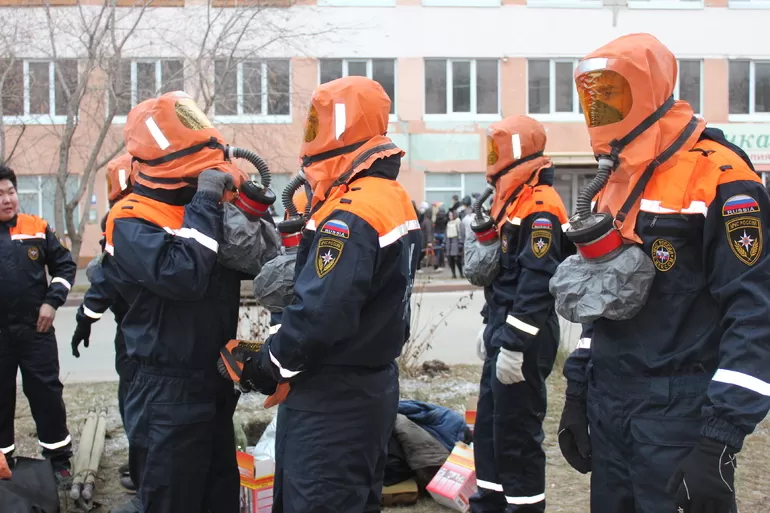
To quickly eliminate the consequences, settlements prepare in advance for emergency situations and conduct exercises. Each apartment must have personal protective equipment. Buildings with large crowds of people are built in a special way to prevent the entry of contaminated air into the building in the event of an accident. The operational work of the media and other means of warning citizens is being established.
The population of cities located in likely affected areas must always be prepared. Training is carried out at work or educational places. People are taught to hide water from contamination, get clean food, and take shelter indoors.
They also study the properties of hazardous chemicals that are used in production, life safety, and first aid products. Everyone needs to be able to protect themselves and their loved ones in the event of a threat.
Dangerous objects
This type of enterprise includes those where hazardous substances are stored, processed and used. Accidents at chemically hazardous facilities can lead to infection of people or their death from exposure to toxic substances.
Such enterprises include the following:
- Chemical and oil refineries.
- Petrochemical industry enterprises.
- Treatment and water treatment facilities where chlorine is used.
- Refrigeration units, if they use ammonia.
- Warehouses where pesticides are stored.
- Vehicles transporting chemically hazardous cargo.
- Chemical industry waste dumps.
All hazardous enterprises can be divided into several categories according to the degree of danger:
- 1st – in the event of an accident, more than 70 thousand people fall into the affected area.
- 2nd – from 40 to 70 thousand.
- 3rd – less than 40 thousand.
- 4th – in the event of an accident, the danger does not extend beyond the boundaries of the enterprise.
There are more than 3 thousand such dangerous objects in our country. With such a quantity, knowledge of the properties of chemical chemicals, a preliminary assessment of possible consequences, and the ability to correctly and quickly take urgent measures to eliminate an accident are the main conditions for ensuring that chemical protection of the population is carried out at the highest level.
